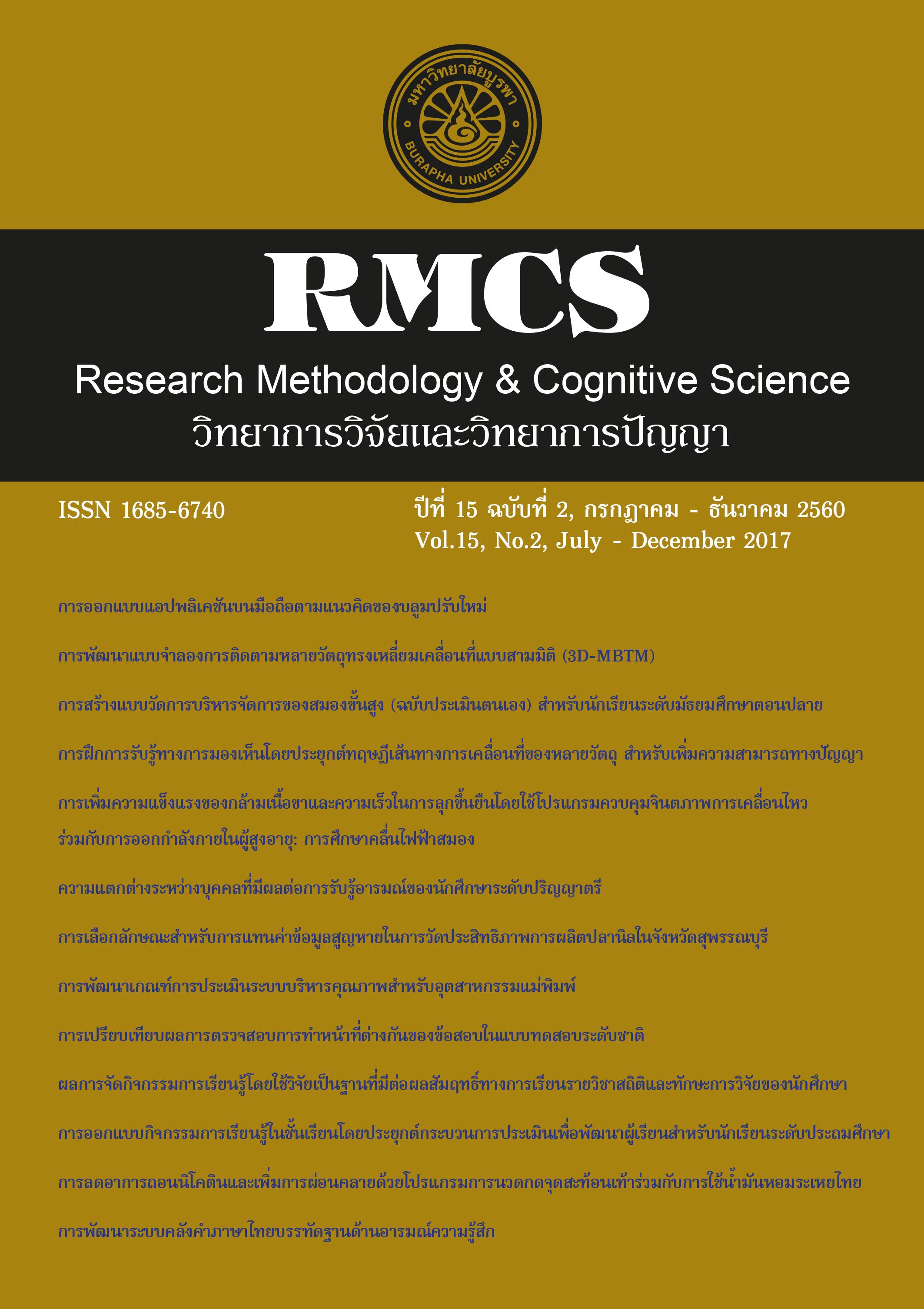Decreasing Nicotine Withdrawal Symptoms and Increasing Relaxation by Using Foot Reflexology Combined with a Thai Essential Aroma Oils Program in Smoking Cessation
Main Article Content
Abstract
Nicotine is a compound found in the cigarettes that can cause addiction, nicotine withdrawal
symptoms and stress when stop smoking. The purposes of this study were to develop foot reflexology
combined with a Thai aroma essential oils program for decreasing nicotine withdrawal symptoms
and increasing relaxation in smoking cessation, and to compare results with those from an active
control group which used only nicotine gum. The participants were sixty male volunteers from the
Health Promotion Hospital, Klongkon District. They were randomly assigned to the experimental
and the active control groups. Research instruments included the nicotine withdrawal scale in
psychological tests and digit symbol substitution test, heart rate monitor, foot reflexology combined
with a Thai aroma essential oils program, and nicotine gum. Data were analyzed by using MANOVA.
The results were as follows:
1) Foot reflexology combined with a Thai aroma essential oils program comprised 16 foot
points reflex and 2 Thai aroma essential oils (Bergamot and Ylang-Ylang). The massage sessions
have been held during 40 minutes per day.
2) In the experimental group, foot reflexology combined with a Thai aroma essential oils
program led to a decrease in nicotine withdrawal symptoms in psychological tests and an increase
in memory performance of digit symbol substitution test. Moreover, it could enhance in relaxation
after using the developed program.
3) The active control group exhibited lower levels of nicotine withdrawal symptoms in
psychological tests on day 2 and day 3 after smoking cessation compared to the experimental
group. However, the levels of nicotine withdrawal symptoms were not significantly different between
groups on day 4 after smoking cessation.
In conclusion, foot reflexology combined with a Thai aroma essential oils program was found
to be effective in decreasing nicotine withdrawal symptoms same as nicotine gum, and serve to
identify this program as a new therapeutic intervention for reducing nicotine withdrawal symptoms
and increasing relaxation after smoking cessation.
Article Details
References
วารสารเกษตรพระจอมเกล้า, 30(2), 78-85.
สำนักควบคุมการบริโภคยาสูบ กรมควบคุมโรค กระทรวงสาธารณสุข และศูนย์วิจัยและจัดการความรู้เพื่อการควบคุม
ยาสูบ มหาวิทยาลัยมหิดล (2559). สรุปสถานการณ์เฝ้าระวังเพื่อควบคุมการบริโภคยาสูบของประเทศไทย พ.ศ.
2559. พิมพ์ครั้งที่ 1กรุงเทพฯ, เจริญดีมั่นคงการพิมพ์.
สำนักงานสถิติแห่งชาติ. (2557). สรุปสำหรับผู้บริหาร การสำรวจพฤติกรรมการสูบบุหรี่และการดื่มสุราของประชากร
พ.ศ. 2557. เข้าถึงได้จาก https://www.msociety.go.th/article_attach/17336/13207.pdf
Barbara. K., & Kevin K. (2005). The complete guide to foot reflexology, (3nd ed.). London: Harper Collins.
Cropley, M., Ussher, M., & Charitou, E. (2007). Acute effects of a guided relaxation routine (body scan)
on tobacco withdrawal symptoms and cravings in abstinent smokers. Addiction, 102(6), 989-993.
Delis, D.C., Lucus, J.A., & Kopelman, M.D. (2000). Memory In: Fogel B.S., Schiffer R.B., & Rao S.M.
(Eds), Synopsis of neuropsychiatry. Philadelphia: Lippincott Williams & Wilkins.
Edmonds, W. A., & Kennedy, T. D. (2013). An Applied Guide to Research Designs: Quantitative, qualitative,
and mixed methods. Thousand Oaks, California, Sage.
Heishman, S. J., Boas, Z. P., Hager, M. C., Taylor, R. C., Singleton, E. G., & Moolchan, E. T. (2006). Effect
of tobacco craving cues on memory encoding and retrieval in smokers. Addictive behaviors,
31(7), 1116-1121.
McMorris, T., Collard, K., Corbett, J., Dicks, M., & Swain, J. P. (2008). A test of the catecholamines hypothesis
for an acute exercise–cognition interaction. Pharmacology Biochemistry and Behavior, 89(1), 106-115.
Parsons, T. (2004). An Holistic Guide to Massage: From beginner to advance level and Beyond. London:
Thomson Learning.
Rankin-Box, D. (2009). MRI research sheds new light on reflexology. Complementary Therapies in Clinical
Practice, 15(2), 119.
Schneider, S., Vogt, T., Frysch, J., Guardiera, P., & Strüder, H. K. (2009). School sport-a neurophysiological
approach. Neuroscience letters, 467(2), 131-134.
Steptoe, A., & Ussher, M. (2006). Smoking, cortisol and nicotine. International Journal of Psychophysiology,
59(3), 228-235.
Weinberger, A. H., Krishnan-Sarin, S., Mazure, C. M., & McKee, S. A. (2008). Relationship of perceived risks
of smoking cessation to symptoms of withdrawal, craving, and depression during short-term smoking
abstinence. Addictive behaviors, 33(7), 960-963.
World Health Organization (WHO). (2016). Get ready for plain packaging. Retrieved from http://www.
who.int/mediacentre/ news/releases/2016/worldno-tobacco-day/en/

